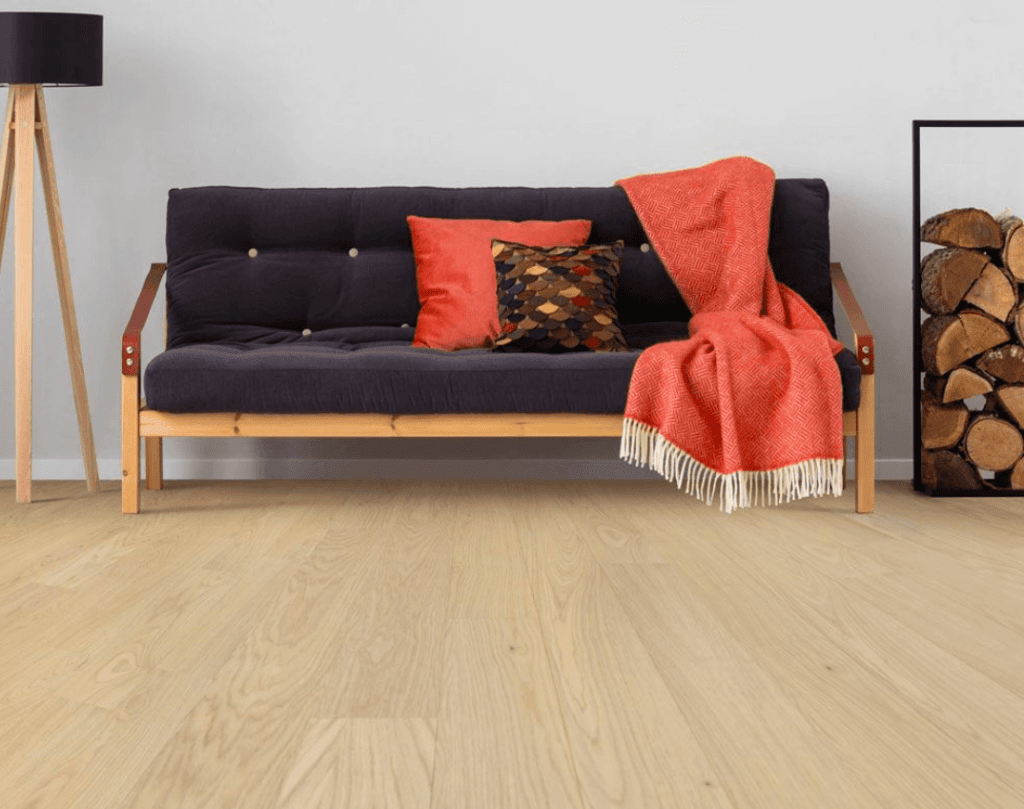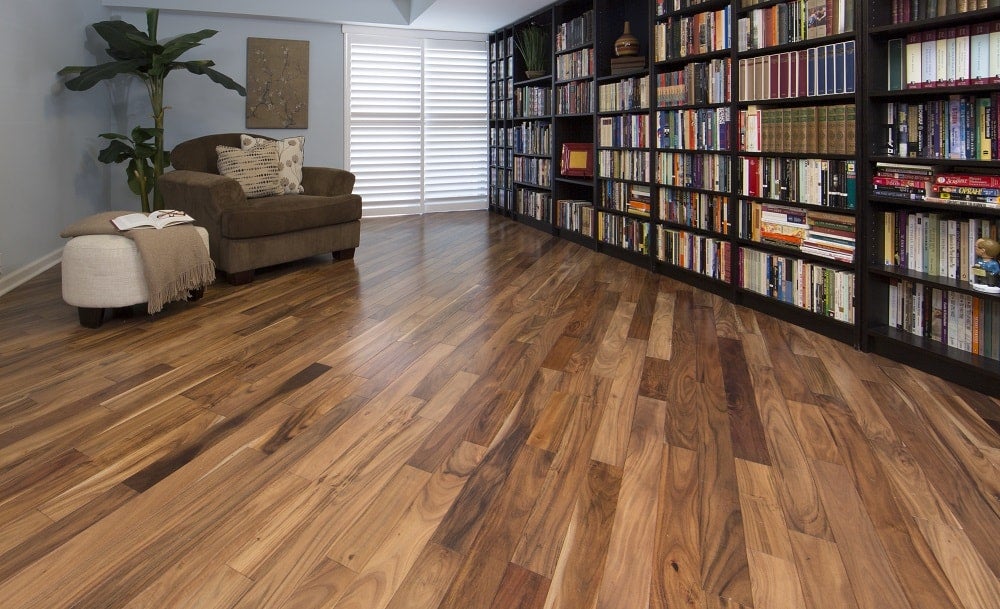Homeowners shopping for new floors these days have the luxury of choosing from nearly limitless options that will fit their needs, even after narrowing down their wish list to include only one particular type of flooring. Those in the market for wood floors, for instance, can pick from genuine hardwood, engineered hardwood, wood laminate, and both sheet vinyl and vinyl plank flooring. That’s quite a bit of the flooring market to cross-shop, just to get the wood floor aesthetic. That amount of choice can even be overwhelming.
However, many customers will quickly narrow their search by being sure they want something made from real wood, as opposed to fully man-made wood-look flooring products. Yet even after making that decision, another choice will be required: between engineered hardwood and solid hardwood flooring. These siblings of the flooring world have lots in common but possess one major difference that gives each product some benefits over the other, as well as some disadvantages. So, what’s the difference between engineered hardwood and solid hardwood flooring?

First let’s discuss the fundamental difference between engineered hardwood and solid hardwood flooring, as well as the similarities. As the names suggest, both are made using bona fide hardwood.
Solid hardwood flooring is made, you guessed it, from a single solid piece of wood. From top to bottom and edge to edge, each hardwood flooring plank is one piece of lumber—no gluing together of multiple smaller pieces, no veneers, and no synthetic layers. It is just wood, cut into planks and dried.
Engineered hardwood, on the other hand, is made only in part from a solid piece of hardwood. While the surface layer of each plank is a single slice of genuine hardwood, the core of an engineered wood plank is made from a stable composite material like high-density fiberboard (HDF). These layers are bonded with industrial adhesive to make a plank that effectively becomes one solid chunk, though it’s not real wood through and through.
What does this difference mean—or not mean—in real-world use? Read on to find out.
Comparing the Look of Each Wood Floor Type
Because the surfaces of solid and engineered hardwood are completely natural wood, a plank of each product will look essentially identical, assuming they both use the same wood species and are finished in the same stain. The grain on every individual plank of each product will be slightly unique, giving both types of wood flooring the sought-after charm and character that man-made products like vinyl plank or wood laminate can never fully match. Conclusion: this one is a tie.

How Do They Feel?
If you were to reach down and touch the flooring surface, both engineered and solid hardwood will feel the same because, again, with each of those planks you’d be running your fingers atop a genuine wood surface. It’s only when scrutinizing the materials side-by-side as fully installed floors that there is the possibility for a tangible difference in how each feels underfoot.
Depending on the particular product used, some engineered wood floors may feel or sound a bit hollow when walked on, because the engineered core is a different density than solid wood. However, it’s highly unlikely that this would be noticeable—and even less likely that it’s something that anyone would consider a negative trait—in regular use. Conclusion: a slight edge to solid hardwood, though it will go unnoticed by the vast majority of homeowners.
Floor Care Requirements
While day-to-day maintenance will be similar for both materials, engineered hardwood has a slight edge when it comes to overall care. First, since the surface layer of both is the same, similar care should be given to each wood flooring type when it comes to avoiding scratches and dings: Be careful when moving heavy furniture, try to keep your dogs’ claws trimmed, and just generally be aware that real wood is softer than most other hard surface floors. Of course, the modern scratch-resistant topcoats available on wood floors from Empire Today® go a long way toward minimizing that type of damage.
When it comes to water damage, both types of floors can easily be harmed by any exposure to liquid water. But in addition to that risk, solid hardwood floors can be affected even just by high environmental humidity, which can warp the planks over time. However, engineered hardwood’s highly stable core gives it a measure of moisture resistance that solid hardwood does not possess. Conclusion: engineered hardwood comes with fewer worries when it comes to day-to-day floor care.
Installation Versatility
Engineered wood flooring’s resistance to moisture gives it the upper hand when it comes to overall versatility. It can be installed in places not suitable for solid hardwood, like the kitchen, or most areas where the regular presence of moisture can easily damage the floor. Engineered hardwood can installed in geographic regions with typically high humidity. It also means that engineered hardwood floors can be installed below grade and directly onto concrete slabs, making it a viable choice for a finished basement. Conclusion: engineered flooring wins this round.
Upfront Cost
Comparing costs of two broad categories is always a tricky proposition because there are so many variables within each style that can affect the overall price tag. Some high-end engineered hardwood floors can cost more than the affordable solid hardwood options. But in general, when comparing engineered hardwood and solid hardwood products of similar look and quality, the engineered wood option will be more affordable. Conclusion: engineered flooring will usually win here.

Long-Term Outlook
This is where the investment in solid hardwood floors pays off. With proper care, a solid hardwood floor can easily last upwards of 50 years. Part of its long life is its ability to be refinished multiple times over its lifespan. During a wood floor refinishing, a very thin layer of wood is sanded off, removing all the scratches and scuffs in the surface, before it gets stained and sealed. The end result is a floor that looks and feels brand new. This is often considered to be an advantage when reselling a home, as well.
Engineered hardwood floors can’t be refinished as often, since there is less real wood to sand down. Though many engineered products can handle the process 1-3 times before they’ll have to be replaced, that may not be enough for those who plan to stay in their forever home for many years. Conclusion: solid hardwood wins when it comes to overall lifespan.
So Which is the Better Choice for You?
As with just about any home improvement decision, it’s impossible to give an objective answer to the question of which product is “better,” because there are so many variables to each customer’s needs and wants. Some prefer the lower cost and easier maintenance of engineered wood flooring, while others simply prefer knowing their floors might last a century, even though they look identical to a more affordable option.
The best way to make your final decision is to spend time with the products and someone who really knows them, and taking the time to learn more about each wood floor type, handle samples of each floor type, and see how they’ll look in your home. To do just that, schedule an Empire® In-Home Estimate and we’ll send over a a flooring pro who will bring a full selection of flooring samples to your home, helping you make this tricky decision with as little hassle as possible.
Get the latest updates delivered to your inbox.